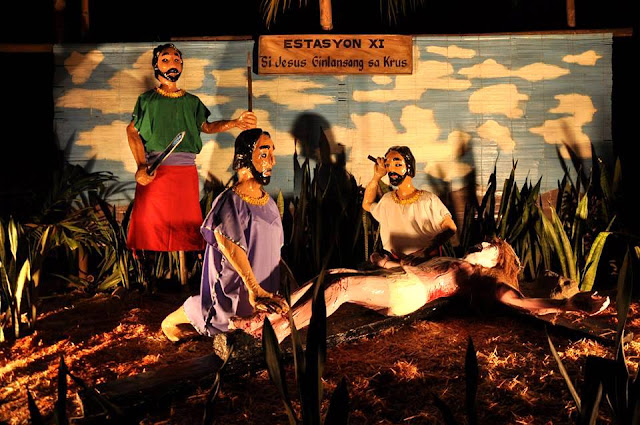 |
| photo courtesy of LGU-Cabatuan |
Iloilo has its own beautiful traditional Lenten celebration. Throughout Lenten season, many towns have precious and moving traditions played out every year during Holy Week or Semana Santa, part of a tradition celebrated throughout the country.
Many
towns spend all year planning for the spectacle and is home to some of the
biggest Lenten traditions. For visitors and tourists here in time for the Lenten
spectacle, towns offer plenty of other things to do.
Church-hopping
is a Lenten base for exploring Iloilo. In the Lenten week, churches will be
shrouded in gloom throughout the week. All are dolled up in black or violet
draperies, the altars covered in darkness and sorrow are decorated with flowers
and are well-lighted. The Way of the Cross or Via Crucis is a popular activity
among families and friends where they go from one church to the other pausing
at each station for quiet meditation and prayer.
Considered
to be the most picturesque of all observances is the dramatic procession that
goes around the main streets from the church in the afternoon of Good Friday.
The towns of Sta. Barbara, Leganes and Igbaras display century-old masterpieces
of realistic figures of main Lenten characters mounted on lavishly decorated
and lit platforms. The floats are convoyed by throngs of faithful holding
candles and rosaries while uttering laments or singing penitential chants
accompanied by lugubrious music.
Theatrical
dramatization of the Passion of Christ brings to life the death of our Lord.
Annually celebrated in the town of Barotac Viejo the Taltal is this town’s way
of maintaining devotion and traditions today.
Annually
in Cabatuan, residents along the streets begin preparations weeks and even
months in advance creating beautifully intricate life-size Lenten characters of
the Stations of the Cross.
Along with this is the traditional Filipino ritual involving an uninterrupted chanting-singing of the verses of the life, death and resurrection of Jesus Christ. The Pasyon is structured in five-line stanzas, with each line containing eight syllables performed in the local dialect, Kiniray-a as a song a capella or with the accompaniment of a guitar. Many Cabatuananons consider Pasyon and Kapiya as their “panata” or personal pledge during Holy Week. It has evolved into a community activity that allows their community devotees to express their faith.
 |
| photo courtesy of LGU-Cabatuan |
Along with this is the traditional Filipino ritual involving an uninterrupted chanting-singing of the verses of the life, death and resurrection of Jesus Christ. The Pasyon is structured in five-line stanzas, with each line containing eight syllables performed in the local dialect, Kiniray-a as a song a capella or with the accompaniment of a guitar. Many Cabatuananons consider Pasyon and Kapiya as their “panata” or personal pledge during Holy Week. It has evolved into a community activity that allows their community devotees to express their faith.
Lent
is a 40-day religious season observed by Christians all over the world. It
starts on Ash Wednesday where the priest dips his thumb into ashes previously
blessed and marks a cross to the forehead of the faithful as a public and
communal sign of penance; and ends on Easter Sunday. During Lent the faithful
perform penance through fasting, giving alms or abstaining from any amusement.
The
Lenten season is an opportunity for adults to discuss these annual practices to
the younger generation. This practices done in the present time is connected to
all other periods of time, those that preceded the present generation and those
that will come after. It is during special occasions such as this that our
unique cultural traditions have the greatest potential to help especially the
present generation for self-definition and to contribute to their well-being.
It is of greatest pride to be a part of the transmission of our particular
family and ethnic customs. In so doing, we come to realize our immortality by
being part of living traditions.









No comments:
Post a Comment